Radio is one of our most important means of communication. It enables people to send words, music, images, codes, and other signals over long distances. People on ships and in aircraft and spacecraft keep in contact with others on land, air, or sea by using radio. People also use radio to communicate far into space.
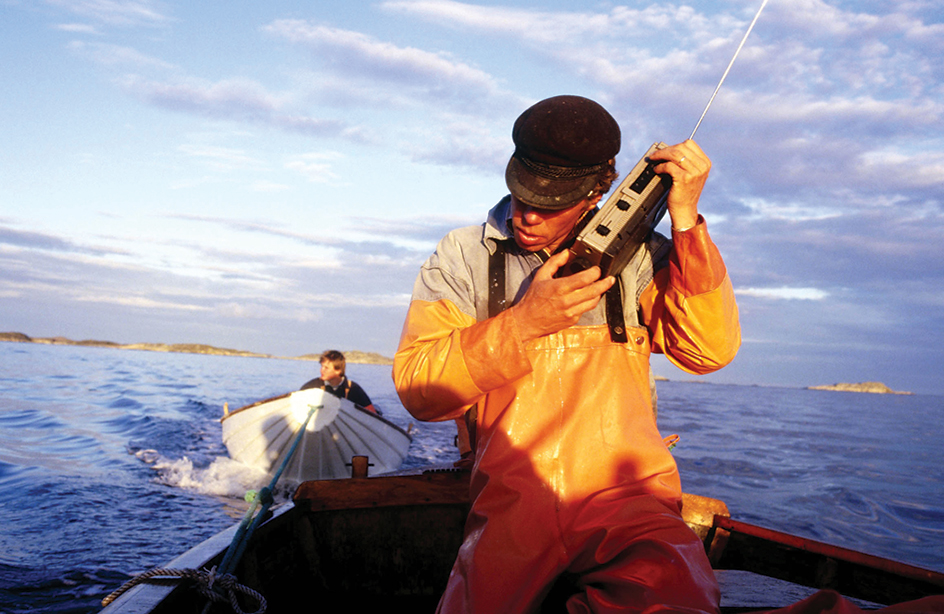
The most widespread and familiar use of radio is for the form of one-way communication known as broadcasting. Radio broadcasts feature music; news; discussions; interviews; sports coverage; drama; educational, cultural, and religious programs; and commercial advertising. Many people wake up to clock radios and listen to radio while in their automobiles. Many also enjoy listening to radio programs during their leisure hours. Some people listen to their favorite radio shows on their computers.
Radio broadcasting once had much the same entertainment role as television has today. From the 1920’s to the early 1950’s, millions of families gathered around their radios every night. They listened to dramas, light comedies, variety shows, live music, and other kinds of programs. This period, which is sometimes called the Golden Age of Broadcasting, ended with the rise of television during the 1950’s.
Radio has many uses in addition to broadcasting. People in many occupations use radio for two-way, wireless communication. Scientists send radio waves into the sky to learn about the weather. Telephone companies send messages across the ocean by radio. Many people operate amateur radio stations.
Radio works by changing sounds or other signals into radio waves, a form of energy called electromagnetic radiation. Radio waves travel through the air and through space. They also go through some solid objects, such as the walls of buildings. A radio receiver changes them back into the original sounds.
Many people contributed to the development of radio, and no one individual can be called radio’s inventor. Guglielmo Marconi of Italy sent the first radio communication signals in 1895. Today, radio waves that are broadcast from thousands of stations, along with waves from other sources, fill the air around us continuously.
Uses
Broadcasting ranks as the most familiar use of radio by far. Every day, millions of people throughout the world listen to radio programs that are broadcast for their entertainment and information. But people also use radio in dozens of other ways. Many uses involve two-way communication, in which radio equipment is used both to send and to receive messages. In broadcasting and in most two-way communication, radio transmits sounds, such as voice and music. But in other uses, radio sends communication signals other than sounds. Such signals include the radio beams used in navigation and the remote control signals used in operating certain kinds of equipment.

Broadcasting.
Most radio broadcasts originate at radio stations. There is at least one radio station in every independent country in the world, and altogether there are tens of thousands of stations.
Some radios are powered by current from electrical outlets. These radios are usually kept in the home, where electrical outlets are readily available. But many radios are powered by batteries. People listen to these radios almost everywhere—in homes and yards, at beaches and picnics, and even while strolling down the street. In addition, nearly all automobiles have a radio.
In some parts of the world, radios provide the people with one of the few links they have to the world outside their village or town. In some places, there is no electric power and batteries are too scarce or expensive for people to buy them. People in such communities sometimes use a special wind-up radio that requires no other source of power. Many people do not own radios, and they listen to radio programs in public gathering places instead.
Two-way communication.
Two-way radio provides communication in an almost endless variety of jobs—whenever there is a need for wireless contact between one point and another. Some of the most important of these uses are in (1) public safety, (2) industry, (3) defense, and (4) private communication.
In public safety.
Police officers and firefighters use two-way radios in their patrol cars and fire engines. They also carry small, portable two-way radios called walkie-talkies. They use these radios to get directions from their headquarters and to communicate with one another (see Walkie-talkie). Airplanes and ships use two-way radios for safe operation and for rescue missions. Special ambulance teams use radio to help save lives after rushing to the scene of an accident. These specialists radio the details of a victim’s condition to a doctor in a hospital. The doctor then directs the emergency treatment of the victim by radio.

In industry.
Two-way radio has become a standard tool of the transportation industry. Taxi drivers receive radioed instructions on where to pick up customers. Airplane pilots receive landing and take-off instructions by radio. Ships, trains, and many trucks and buses are equipped with two-way radios.
Radio also helps save time, money, and work in many other industries. Construction workers use it to communicate from street level to the top of a skyscraper. With the aid of two-way radio, farmers, ranchers, and lumber workers receive information when they need it and get equipment delivered where they want it.
In defense,
radio plays a key role by linking a country’s defense units. Military personnel use radio equipment in planes and tanks and on ships. Large communications centers and handy walkie-talkies help provide instant contact between military units.
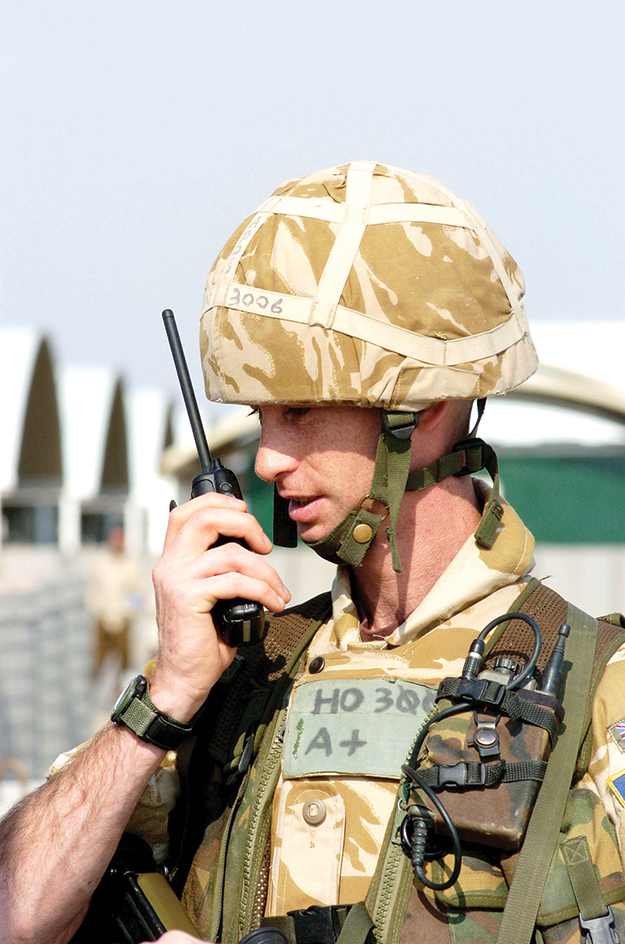
In private communications.
Many licensed radio operators called hams send and receive long-distance messages by radio as a hobby. Children play with walkie-talkies that broadcast over short distances. Many people use two-way radios in such places as cars and pleasure boats. One type of radio used by private citizens for short-distance, two-way communication was citizens band radio. Radio signals also enable people to communicate using portable cellular telephones and through wireless local area networks.
Other uses.
Radio waves can carry many more kinds of information than just sounds. Radio signals make possible the operation of navigational aids, remote control devices, and data transmission equipment. In addition, radio has several highly specialized uses.
Navigation.
Radio beams made up of special navigation signals help airplane pilots stay on the proper flying course. Many ships have devices for mapping their position with the aid of signals radioed from shore. Airplanes and ships also rely on radar—a special form of radio—for their safe operation (see Radar).
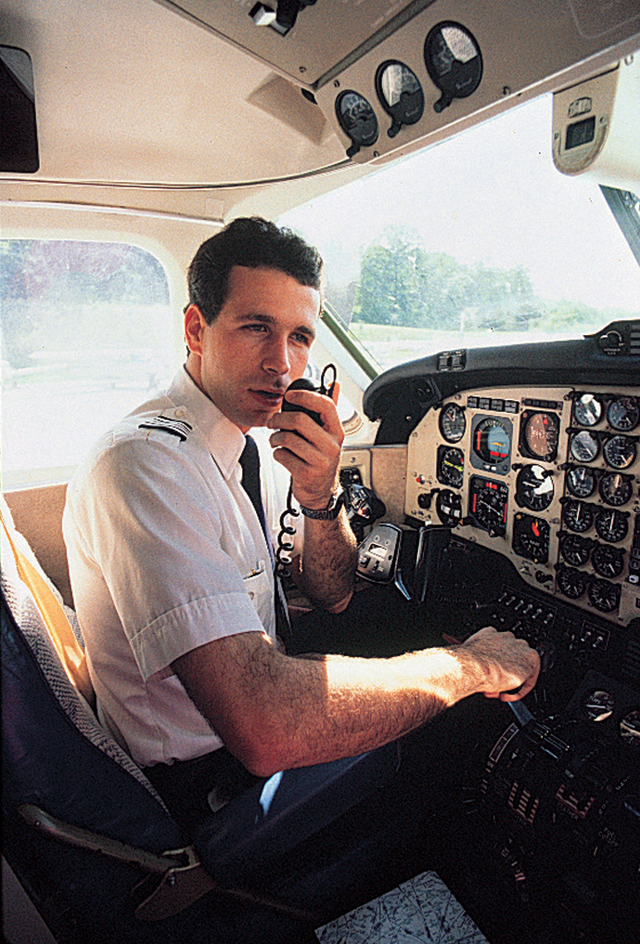
Remote control
by radio can be used to guide the flight of a model airplane or a real plane that has no pilot. Radio-controlled devices also direct railroad cars in switching yards. In addition, radio-controlled devices do such jobs as opening garage doors or changing television channels (see Remote control).
Data transmission.
Radio equipment can send large quantities of information at great speeds. Data transmission usually occurs between one electronic device and another. For example, radio equipment on the ground may transmit data to a computer in a spacecraft orbiting Earth.
Special uses.
Criminals and law enforcement officials sometimes use hidden radio devices called bugs to listen in on conversations in attempt to gather information. High-energy radio waves cook food in microwave ovens.
Radio programming
Radio programming varies from country to country. In most countries, a majority of programs broadcast are designed for entertainment. The rest provide some type of information. Advertisements are broadcast during and between the programs of commercial stations. Noncommercial stations, also called educational or public stations, have few or no commercials. Radio stations compete with one another for listeners. Most stations choose programs to appeal to a specific audience, called a target demographic. For example, stations in the United States that play rock music try to attract teenage and young adult listeners.
Entertainment.
Recorded music is the chief kind of radio entertainment. Most stations specialize in one kind of music, such as rock, classical, country, or jazz. Some stations broadcast several kinds of music.
Most radio stations that broadcast music have disc jockeys who introduce and comment on the music. They play an important role. Commercial stations try to hire disc jockeys whose announcing styles and personalities appeal to the station’s largest audience.
Additionally, entertainment programs include comedy shows, serials, and plays that are performed live or recorded in a studio by actors. Some plays are written especially for radio.
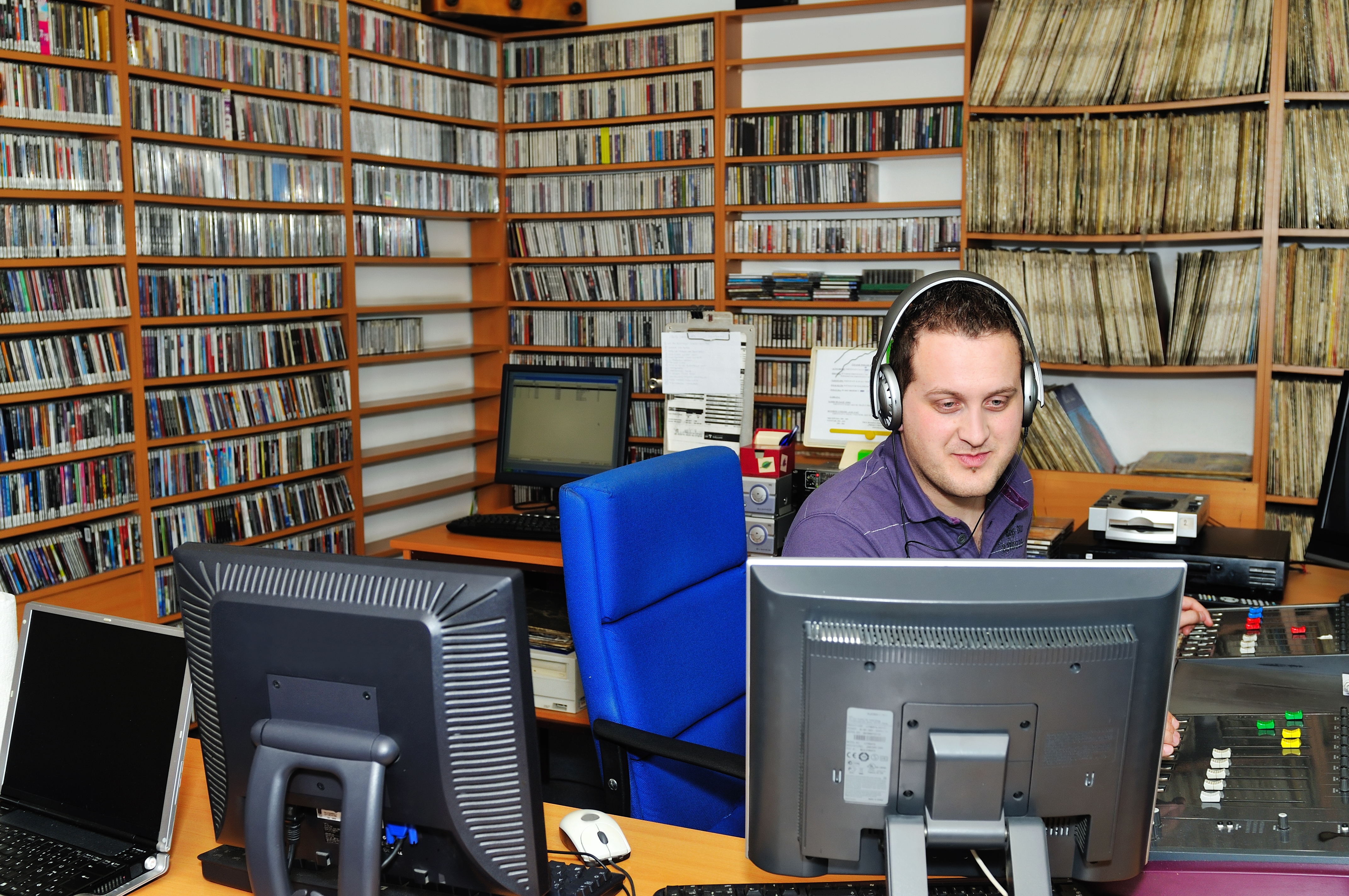
Information.
Programs that provide information include newscasts, talk shows, and live broadcasts of sports events. Newscasts are broadcast at regular times—every half-hour or hour on some stations. In addition, radio stations present on-the-spot news coverage of such events as political conventions, disasters, and speeches by national leaders. Radio stations also broadcast such specialized news as weather forecasts, traffic reports, and stock market information. Other information features include public service announcements about community events and government services. A few stations broadcast only news.
Talk shows present discussions on a variety of topics and interviews with people from many professions. Each show has a host who leads the discussion or does the interviewing. The subject of a program may be a current political topic, such as an election or a government policy, or it may deal with a social issue, such as crime, pollution, poverty, racism, or sexism. Many talk shows allow listeners to take part in the program. Listeners are invited to telephone the station to ask questions or give their opinions about the topic.
Sports events, like news, have always been an important part of radio programming. Sports announcers try to capture a game’s action and excitement for the listeners. Games in many professional sports, such as baseball, basketball, cricket, football, hockey, and soccer, are broadcast locally on radio. Radio stations also broadcast many college and some high school sports contests. Stations that broadcast only sports and discussions of sports are also popular.
How radio programs are broadcast
Radio stations
are places where radio broadcasts begin. The studio is the part of the radio station from which programs are broadcast. It is soundproofed so that no outside sounds can interfere with the broadcasts. Many studios have two separate areas—the main studio and the control room. The main studio is the place where the performers do their jobs. The control room contains the equipment needed to prepare and broadcast programs. This equipment includes the control board, a panel with the switches, knobs, buttons, and other devices used to regulate the sounds of the broadcasts. A large window in the wall between the main studio and the control room enables people in each area to see one another.
Putting a show on the air
involves such jobs as researching current events, script writing, announcing, and controlling the broadcasting equipment. Some shows have a producer who contacts guests and helps prepare interviews. At a small station, the same person may write scripts, announce, play recordings, and even operate the controls. A large station has a staff that plans programs, including the writing of news and other scripts. An announcer may use a script or may simply adlib (speak without a script).
During the Golden Age of Broadcasting, the production of some radio programs was a complex process involving many people. Writers wrote scripts for comedies, dramas, and variety shows. A director guided actors and actresses, who stood around a microphone reading their lines. An announcer introduced the show, closed it, and read the commercials. Sound-effects specialists created such sounds as thunder, footsteps, creaking doors, and galloping horses. An orchestra played appropriate music. Most radio stations were in hotels, and many radio shows were broadcast live (while they were being performed). These shows were often performed on the stage of a hotel ballroom or a theaterlike studio in front of an audience.
Today, the production of most radio programs is less complicated. Only a small number of radio shows are broadcast in front of a live studio audience. Most shows today take place in the radio studio, where only the on-air staff is heard. New technology has even enabled some radio hosts to broadcast directly from their homes. Most programs consist of conversation and recorded music. In addition, many radio stations use computers to do much of the work formerly done by people, such as operating technical equipment, recording program information, and even running the control board. Automation saves money by reducing the number of employees needed to run the station.
From sound waves to electric waves.
A radio program consists of speech, music, and other sounds. These sounds may either be live or prerecorded. Prerecorded sounds are not broadcast when first produced. Most are stored on tapes or audio compact discs (CD’s) and broadcast later. Almost all the music and commercials heard on radio are prerecorded.
To understand how radio broadcasting works, it is necessary to know what sound is. All sounds consist of vibrations. The number of vibrations each second is the frequency of the sound. For example, the sound of a person’s voice consists of vibrations of the air that are caused by the person’s vibrating vocal cords. The faster the vocal cords vibrate, the higher the frequency. The slower the vocal cords vibrate, the lower the frequency. Sound travels through the air in the form of waves called sound waves.
During a live radio broadcast, a microphone picks up speech and other sounds that make up the program. When sound waves enter the microphone, they cause an electric current that runs through the microphone to vary. The variations in the current form electric audio-frequency waves that match the program’s sound waves. Prerecorded sounds are also changed into audio- frequency electric waves before being broadcast.
From electric waves to radio waves.
The electric waves representing the live and prerecorded sounds of the program travel over wires to the control board. A technician uses switches on the control board to select, adjust, and mix the material to create the program signal that will be broadcast. The program signal travels from the control board to the transmitter, either by wire or by a special beam of radio waves.
Low-power transmitters may be in the studio. High-power transmitters are generally far away from the studio, at the site of the transmitting antenna, the device that sends radio waves through the air. Special types of radio waves called microwaves are sometimes used to send the program signal from the studio to a distant transmitter in a narrowly focused “beam.”
In the transmitter, the program signal is combined with electric waves called radio-frequency waves. Radio-frequency waves have a much higher frequency than do the audio-frequency waves that make up the program signal. Radio-frequency waves are also known as carrier waves because they “carry” the program signal from the transmitter to radios. Carrier waves are used because they travel through the atmosphere better than the original audio-frequency waves can. The frequency of the carrier waves produced in the transmitter is the station’s broadcast frequency—that is, the frequency to which a radio must be tuned to hear that station. 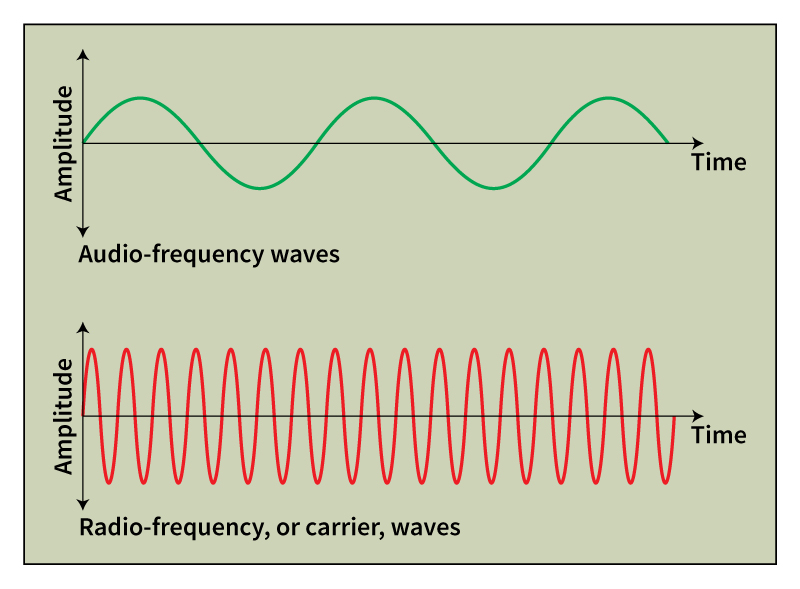
Transmitting radio waves.
After the program signal is combined with the carrier waves, the transmitter amplifies (strengthens) the combined radio signal and sends it to the antenna. The antenna then broadcasts the radio signal through the air.
Radio waves travel at the speed of light. This speed is 186,282 miles (299,792 kilometers) per second. By contrast, sound waves move through the air at the speed of only about 1/5 mile (0.3 kilometer) per second.
Most radio broadcasts are transmitted in one of two ways, depending on how the carrier waves and program signal are combined. These two kinds of radio transmission are amplitude modulation (AM) and frequency modulation (FM). In AM band transmission, the amplitude (strength) of the carrier waves is varied to match changes in the program signal coming from the radio studio. In FM band transmission, the amplitude of the carrier waves remains constant. But the frequency of the carrier waves is varied to match changes in the program signal. The radio wave signal properties described here depend on the carrier frequencies used by the AM and FM broadcasting systems.
Transmitting AM band signals.
An AM antenna sends out two kinds of radio waves—ground waves and sky waves. Ground waves spread out horizontally from the transmitting antenna. They travel through the air along Earth’s surface and follow the curve of Earth for a short distance. Sky waves spread up into the sky. When they reach a layer of the atmosphere called the ionosphere or the Kennelly-Heaviside layer, they are reflected down to Earth (see Ionosphere). AM broadcasts are thus reflected beyond Earth’s curve. The ionosphere rises at night and so reflects AM waves farther than it does during the day. As a result, radios can receive broadcasts from distant stations more clearly at night.
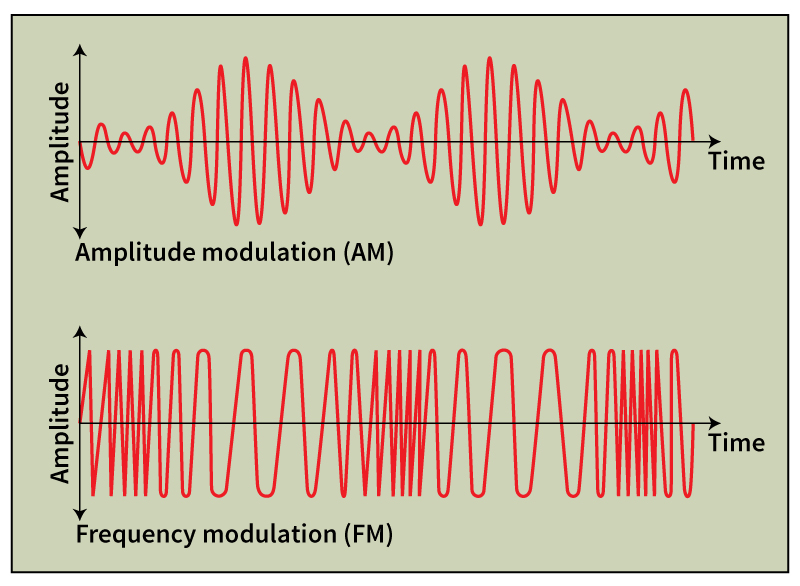
Transmitting FM band signals.
An FM radio antenna sends out waves that travel in the same directions as AM waves, but FM waves that travel skyward are not reflected. Instead, they pass through the atmosphere and go into space. The FM waves that spread horizontally travel in what is called line-of-sight. This means that FM waves cannot be received farther than the horizon as seen from the antenna.
Transmitting short-wave signals.
Many broadcasting stations operate in the short-wave bands. Short-wave broadcasts travel over long distances. In some sparsely populated areas, only short-wave broadcasts can be received. Generally, programs transmitted by short-wave stations are addressed to audiences far away.
Most short-wave broadcasting stations transmit on several frequencies to ensure worldwide reception at different times of the day and year. Programs consist mainly of international and national news, commentaries, interviews, music and other cultural programs, sports events, radio plays, and language courses. The governments of some countries block short-wave broadcasts during periods of political unrest.
The ionosphere reflects short waves best when the solar activity is greatest. Thus, short-wave transmissions travel farther during the day than at night. They also travel farther in the winter, when the sun is farther away. However, eruptions on the sun’s surface called solar flares may disturb the ionosphere enough to interfere with communication or even cause blackouts of short-wave reception.
Digital audio broadcasting (DAB).
Beginning in the early 1990’s, several countries began experimenting with digital audio broadcasting (DAB). For DAB broadcasts, sound is sampled by taking thousands of segments of sound per second and translating each into digital (numeric) code. The digital data are compressed by eliminating parts of the signal that do not change from sample to sample, and the signal is transmitted.
DAB can deliver sound of the same quality provided by a compact disc. DAB can also deliver data services. Some AM and FM radio transmitters must be modified to broadcast DAB. Special receivers are required to receive DAB.
One form of digital audio broadcasting is satellite radio. Satellite radio systems use satellites to broadcast more than 120 channels of coded digital audio signals directly to special radio receivers or to ground-based repeaters that rebroadcast the signals. Computer chips (circuits) in the receivers decode the signals to produce high-quality audio signals. The satellites may be in either a geostationary orbit, remaining in a constant position relative to Earth, or a circular or elliptical (oval-shaped) orbit around Earth. Companies typically offer satellite radio service by subscription. Some offer adapters that allow conventional radios to receive satellite radio signals.
Webcasting and podcasting.
In the mid-1990’s, some radio stations began transmitting, or webcasting, over the Internet. Radio stations carry computer signals to and from the Internet via wireless local area networks (LAN’s). LAN’s are small networks that connect computers in one office, school, or building. Stations may stream their programming—that is, simultaneously broadcast into the air and onto the Internet. Stations may also podcast, or release a digital audio recording on the Internet.
Broadcasting power and frequency.
Another factor that influences the distance a radio program can broadcast is the power of the transmitter. The strongest AM stations have a power of 50,000 watts. They can be heard far away, especially at night when reflected waves travel farther. For example, 50,000-watt stations in Chicago can be heard at night by listeners in Florida, about 1,000 miles (1,600 kilometers) away. The weakest AM stations operate at 250 watts and usually serve only one or two towns.
The power of FM stations ranges from 100 watts, which can broadcast about 15 miles (25 kilometers), to 100,000 watts, which can broadcast about 65 miles (105 kilometers). Some noncommercial FM educational stations operate at as little as 10 watts and reach an area of only a few miles or kilometers.
Each station broadcasts on a different channel, also called an assigned frequency. The use of different carrier frequencies keeps stations from interfering with one another’s broadcasts. Frequency is measured in units called hertz (cycles per second). One kilohertz (KHz) equals 1,000 hertz, and 1 megahertz (MHz) equals 1,000,000 hertz. AM stations transmit within the medium-wave band, which ranges from 535 to 1,705 kilohertz. FM stations transmit within a very high frequency (VHF) band that ranges from 88 to 108 megahertz. The short-wave band ranges from 3 to 30 megahertz. The L-band, within which most DAB signals are broadcast, ranges from 1,452 to 1,492 megahertz.
How radio programs are received
Radios detect radio-frequency signals, separate the program signals from the carrier waves, and then change the program signals into sound waves. Different types of radios can receive different broadcast bands. Many radios can receive both AM and FM, the most popular broadcast bands. Multiband radios can pick up AM, FM, and other bands, such as police, marine, aviation, and short-wave bands.
One of the simplest radio receivers is the crystal radio. This type of receiver uses an electronic device called a crystal rectifier to detect changes in the strength of an AM signal. These changes in signal strength represent the program’s original sound waves. A crystal radio works on just the power of the radio waves it receives and needs no electric power source. However, a listener must use earphones because a crystal radio can produce sound only at a low volume. Furthermore, this type of radio does not receive FM broadcasts well. Because of such limitations, most radios made today are electrically powered.
The electric power for a radio can come from batteries or from an electrical outlet in a house or other building. A typical radio that runs on household power has a component called a power transformer that lowers the household voltage to the level the radio requires.
The main parts of an electrically powered radio include (1) the antenna, (2) the tuner, (3) the intermediate-frequency amplifier and detector, (4) the audio-frequency processor and amplifier, and (5) the speaker. A radio that can receive more than one type of signal also has a switch for selecting the band.
The antenna
is the length of wire or a metal rod that converts radio waves in the atmosphere to electrical signals at the antenna terminal (end point). The antenna may be entirely inside the radio, or part of the antenna may be outside the radio but connected to it, as is the case in automobile radios. An antenna receives radio waves from many stations at the same time.
The tuner
is the part of the radio that can be adjusted to particular frequencies. A display on the radio shows the frequencies, or channels, of the stations that may be tuned in. For example, station WQAM in Miami broadcasts on a frequency of 560 kilohertz. To tune in WQAM, a listener selects number 560 (abbreviated as 56 or 5.6 on some radio displays).
Today, most radio receivers use the superheterodyne tuning method because of the advantages it offers. The tuner of a superheterodyne radio consists of three main parts: (1) an amplifier, (2) a local oscillator, and (3) a mixer/converter. The amplifier strengthens the antenna signal. The local oscillator generates a signal of a specific frequency, which the mixer/converter combines with the amplified antenna signal. The combined signal, called the intermediate frequency, contains a particular radio program. When a listener adjusts the tuning control, the local oscillator frequency changes and a different radio program is selected to be on the intermediate frequency. The intermediate frequency is 10.7 MHz for FM and 455 KHz for AM. Use of the same intermediate frequency to process many radio frequencies simplifies the radio’s design. It also allows for improved selectivity—that is, the radio’s ability to pick a desired radio signal from among the many received by the antenna.
The intermediate-frequency amplifier and detector
receive the intermediate-frequency signal produced by the tuner. The amplifier strengthens the signal, which then enters the detector. The detector removes the intermediate-frequency components from the signal and leaves only the audio-frequency signal—the part that represents the program.
The audio-frequency processor and amplifier
strengthen the audio-frequency portion of the signal. Volume, bass, and treble controls can be used to adjust the loudness and tone of the sound before it goes to the speaker.
The speaker
is the final link between the broadcasting studio and the listener. It changes the electrical signal back into sound waves that represent the original program sounds. The basic parts of a speaker are a magnet and a coil of wire called the voice coil. The voice coil is attached to a cone, which is usually made of paper. The electric current from the amplifier passes through the coil and exerts varying push and pull against the magnet’s field. The cone vibrates in time with the electric current flowing through the coil. The cone’s vibrations create sound waves that match those that first went into the microphone or were recorded earlier, and the original program sounds come out of the speaker.
Stereophonic receivers
can detect stereophonic, or stereo, multiplex signals. These signals are formed by sending two separate audio-frequency signals on a single carrier frequency at the same time. The two audio-frequency signals are called the right channel and the left channel. Stereo multiplex signals better re-create for the listener the sensation of hearing live sounds than do monophonic signals, which transmit only one channel.
Both stereo and monophonic receivers have a super-heterodyne circuit. However, stereo receivers have an additional circuit called a demultiplexer. This circuit changes the multiplex signal back into its original left and right channels. The two parts of the signal then enter separate audio-frequency processors and amplifiers. Stereo receivers have at least two speakers, one for each channel.
DAB receivers
are required to pick up DAB signals. Such receivers recombine a DAB signal’s components and restore the original sound even if reception has been affected by interference.
Radio data system (RDS) receivers
pick up special signals that provide data in addition to audio broadcasts. Radio stations throughout the world have adopted an FM-based multiplex system for such signals. The additional data provide listeners with new features, including the ability to find stations based on type of program, such as classical music, rock and roll, or news. A special demultiplexer circuit is needed in the radio to receive and use the information. RDS radios are popular in cars in many countries.
The radio industry
Radio has several important industrial roles. Broadcasting stations provide jobs for thousands of workers around the world. Radio commercials help other businesses sell every kind of product and service—from dog food to automobiles to insurance. The recorded music played by disc jockeys is often an important factor affecting the sale of music. Stores throughout the world sell millions of radio receivers each year.
Stations and networks.
There are two main types of radio stations—commercial stations and public stations. Commercial stations, which are owned by private companies, make profits from advertisements. Public stations are funded at least partly by the government. However, in some countries, public stations also take advertisements. Some countries also have nonprofit radio stations, many of which are operated by educational institutions. A radio station may employ only a few workers or as many as several hundred.
The organization of radio broadcasting varies from country to country. In the United States, for example, almost all commercial radio stations are privately owned businesses. Most European countries have both commercial stations and nonprofit stations. Most countries have at least one commercial radio station.
Commercial radio stations broadcast programs to attract listeners. They sell broadcasting time to advertisers who want to reach these listeners. Sponsors pay the stations for time during and between the programs to advertise their products. Stations that attract the largest audiences receive the highest fees. Many commercial stations have an affiliation (working agreement) with a national network. A network is an organization that provides some of the programming for its affiliated radio stations. It may also sell some of the stations’ advertising time. Networks send radio signals to their affiliates using communications satellites.
Careers.
The radio industry offers a variety of career opportunities. Stations and networks need program planners and announcers, news reporters and newscasters, technicians, and maintenance workers. Other personnel write scripts, sell advertising time, and work in such general business activities as accounting and public relations. An employee of a small radio station may be called on to do any of these jobs at one time or another. Therefore, a job with a small station provides excellent experience for a person starting a radio career. Most people who hold a key job at a large station first gained experience by working at small stations.
Employees of large stations or networks generally specialize in one of four kinds of work. These kinds of work are (1) programming, (2) engineering, (3) sales, and (4) general administration.
The programming department is headed by a program director. This department includes journalists who gather the news and write news reports and other material to be broadcast. Other members of the programming department include announcers, copywriters, and production personnel. The engineering department includes the technicians who operate and maintain the broadcasting equipment. Members of the sales department are responsible for selling broadcasting time to sponsors. The general manager of the station or network heads the department of general administration and has overall responsibility for the organization’s operation. The general administration department includes accountants, secretaries, and other office workers.
Careers outside of broadcasting are available to people trained in the operation and repair of radio equipment. Many people skilled in radio repair go into business for themselves.
Government regulation of radio
The government of every country regulates the use of radio in some way. Without regulation, radio stations and other radio users would broadcast signals that would interfere with one another and make it impossible for communications to be understood. Another reason for regulation is to ensure that stations adhere to the terms of their broadcast licenses. Many governments regulate radio in a way that enables them to use the medium to promote their own ideas and policies. They also effectively prevent the broadcast of ideas that government leaders oppose.
Many nations have private and government-owned stations. In most other countries, the government owns all the stations. In the United States, the federal government does not control any radio stations that broadcast to the general public.
In general, a country allows radio broadcasters the same degree of freedom it allows its citizens. Most democratic countries allow wide freedom in broadcasting. Many totalitarian governments severely regulate and censor broadcasting for political purposes.
In the United States, the Federal Communications Commission (FCC) regulates all nonmilitary communication by radio. The FCC assigns frequencies and call letters for various types of radio operations, including broadcasting, amateur radio operation, and marine and aviation radio. In addition, the FCC issues licenses to stations and certain other users of transmitting equipment. The FCC does not censor radio programs or tell stations what programs they should broadcast. But it can impose a fine on or revoke the license of a station that violates broadcasting rules.
In Canada, the Canadian Broadcasting Corporation/Radio-Canada (CBC/Radio-Canada) provides the programs for the government stations. The Canadian Radio-television and Telecommunications Commission supervises government and private stations. In the United Kingdom, the British Broadcasting Corporation (BBC) regulates the government-owned stations. The Office of Communications (commonly called Ofcom), a government agency, regulates privately owned stations.
History
The development of radio in the late 1800’s revolutionized communication. At that time, people had two other means of quick, long-distance communication—telegraph and telephone. But the signals sent by both these devices had to travel through wires. As a result, telegraph and telephone communication was possible only between places that had been connected by wires. Radio signals, on the other hand, passed through the air. Thus, radio enabled people to communicate quickly between any two points on land, at sea, and—later—in the sky, and even in space.
Radio broadcasting, which began on a large scale during the 1920’s, caused major changes in the everyday lives of people. It brought a tremendous variety of entertainment into the home for the first time. It also enabled people to learn about news developments as they happened or shortly afterward.
Early development.
Radio, like many other inventions, developed from the theories and experiments of many people. Joseph Henry, a professor at the College of New Jersey (now Princeton University), and a British physicist, Michael Faraday, discovered one of the first important ideas in the early 1830’s. Both men had experimented with electromagnets. Separately, they each developed the theory that a current in one wire can produce a current in another wire, without the wires being connected. This idea is called the induction theory.
In 1864, the Scottish physicist James Clerk Maxwell helped explain the induction theory by suggesting the existence of electromagnetic waves that travel at the speed of light. During the late 1880’s, the German physicist Heinrich Hertz did experiments that proved Maxwell’s theory.
Nikola Tesla, an American inventor from Austria-Hungary, has been credited with the invention of the radio, based on his early patents for radio communications equipment. In 1891, he invented the Tesla coil, a type of high-frequency transformer. This device is a vital component of radio transmitters.
In 1895, Guglielmo Marconi, an Italian inventor, combined earlier ideas and his own ideas and sent the first radio communication signals through the air. He used electromagnetic waves to send telegraph code signals a distance of more than 1 mile (1.6 kilometers). In 1901, Marconi’s radio equipment sent code signals across the Atlantic Ocean from England to Newfoundland (now Newfoundland and Labrador), Canada. 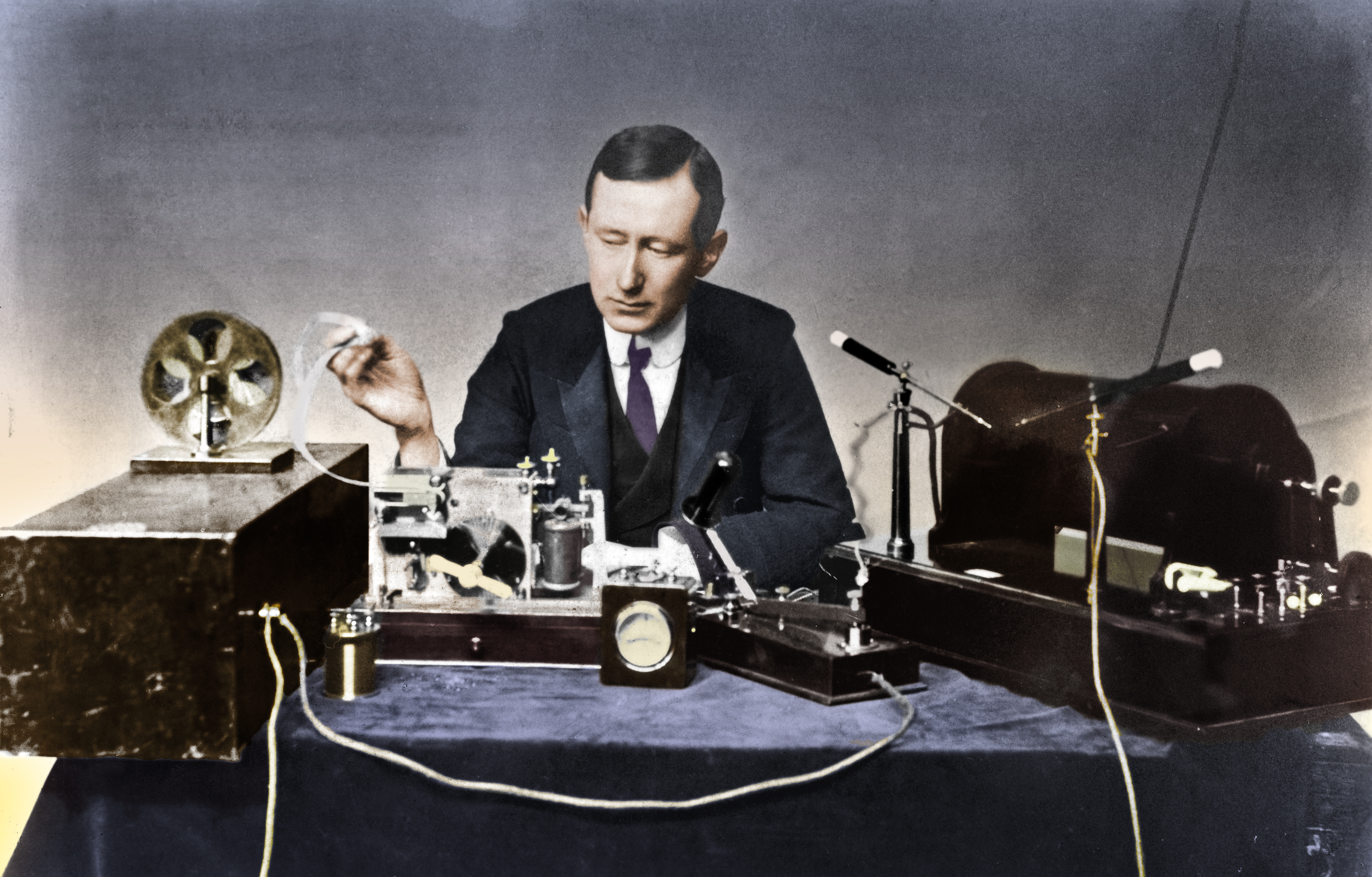
Marconi describes first transatlantic wireless communication
During the early 1900’s, electrical engineers developed devices called vacuum tubes that could be used to detect and to amplify radio signals. Lee De Forest, an American inventor, created a vacuum tube called a triode in 1906. This tube became the key element in radio reception.
There are many claims for the first broadcast of human speech over the air. Most historians give credit to Reginald A. Fessenden, a Canadian-born physicist. In 1906, Fessenden spoke by radio from Brant Rock, Massachusetts, to ships offshore in the Atlantic Ocean. The American inventor Edwin H. Armstrong did much to improve radio receivers. In 1918, he developed the superheterodyne circuit. In 1933, he discovered how to make FM broadcasts.
The first practical use of the “wireless,” as radio was then called, was for ship-to-ship and ship-to-shore communication. Radio helped save the lives of thousands of victims of sea disasters. The first sea rescue involving the use of radio took place in 1909, after the S.S. Republic collided with another ship in the Atlantic Ocean. The Republic radioed a call for help that brought rescuers who saved almost all the passengers.
Dozens of new uses were soon found for radio. By the 1930’s, airplane pilots, police officers, and military personnel were using radio for wireless communication. 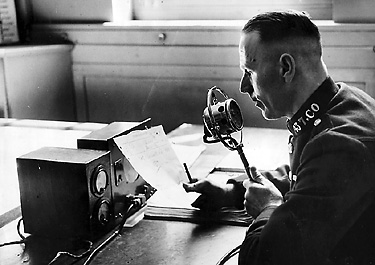
The start of broadcasting.
Experimental radio broadcasts began about 1910. In that year, Lee De Forest produced a radio program from the Metropolitan Opera House in New York City. The program starred the famous opera singer Enrico Caruso.
Many people consider radio station WWJ (then known as 8MK), in Detroit, the first commercial radio station. It began regular broadcasts on Aug. 20, 1920. Others claim the distinction for station KDKA in Pittsburgh. KDKA grew out of an experimental station that began in 1916 in Wilkinsburg, a suburb of Pittsburgh. KDKA’s broadcast of the 1920 U.S. presidential election results on Nov. 2, 1920, is generally considered the beginning of professional broadcasting, even though 8MK also broadcast the election. The first license to broadcast regularly went to station WBZ in Springfield, Massachusetts. The U.S. government issued the license on Sept. 15, 1921.
Network broadcasting began as early as October 1921. At that time, WJZ in New York City and WGY in Schenectady, New York, broadcast the World Series. The two stations formed a simple network connected by telephone lines. Network broadcasting—or, as it was called, chain broadcasting—soon included stations across the United States. The Radio Corporation of America (RCA) formed the National Broadcasting Company (NBC), which was the first permanent national network, in 1926.
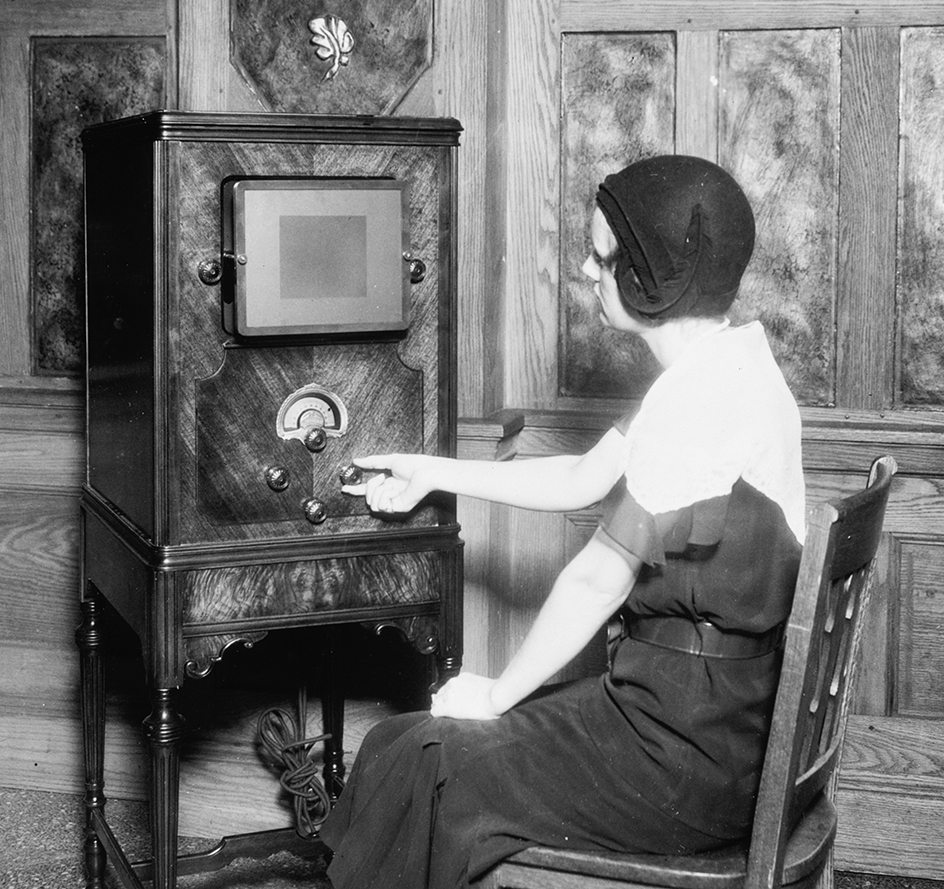
In the 1920’s, radio stations began operating in many other countries as well. The British Broadcasting Corporation (BBC) began broadcasting in 1922. Stations began operations in Australia in 1923 and in Japan in 1925.
The Golden Age of Broadcasting
began in the United States about 1925 and lasted until the early 1950’s. During this period, radio was a major source of family entertainment. Every night, many families gathered in their living rooms to listen to comedies, adventure dramas, music, and other kinds of radio entertainment. Children hurried home from school to hear afternoon adventure shows. In the daytime, millions of people listened to dramas that were called soap operas because soap manufacturers sponsored many of them.
Radio brought to the home the music of famous band leaders, including Tommy Dorsey, Duke Ellington, Benny Goodman, Harry James, Guy Lombardo, and Glenn Miller. Exciting radio dramas of the Golden Age included “Buck Rogers in the 25th Century,” “Gangbusters,” “The Green Hornet,” “Inner Sanctum,” “Jack Armstrong, the All-American Boy,” “The Lone Ranger,” “The Shadow,” and “Superman.” Some radio soap operas were “The Guiding Light,” “John’s Other Wife,” “Just Plain Bill,” “Ma Perkins,” “One Man’s Family,” “Our Gal Sunday,” and “Stella Dallas.”
Radio’s famous comedians included Fred Allen, Jack Benny, Eddie Cantor, and Bob Hope. The ventriloquist Edgar Bergen and his dummy, Charlie McCarthy, hosted a weekly comedy program with famous stars as guests. Situation comedies included “Fibber McGee and Molly,” “The Great Gildersleeve,” “Duffy’s Tavern,” “Henry Aldrich,” and “Our Miss Brooks.” The husband-and-wife comedy team of George Burns and Gracie Allen gained fame in radio.
The popularity of “Amos ‘n’ Andy,” a situation comedy, and the impact of a dramatic program called The War of the Worlds help illustrate the enormous influence radio entertainment had on people. “Amos ‘n’ Andy” was broadcast each weekday throughout the 1930’s. While the program was being broadcast—from 7:00 to 7:15 p.m. Eastern Standard Time—many movie theaters stopped their films and turned on radios so the audiences could listen to the program. Some stores and restaurants played radios over public address systems so that customers would not miss it. Although “Amos ‘n’ Andy” was immensely popular, it also became controversial. The actors and actresses on the radio show were whites who portrayed blacks. Many people have criticized the program for portraying African Americans as a stereotyped group to be laughed at. Some people tried to have the show taken off the air.
The War of the Worlds, broadcast on Oct. 30, 1938, was one program in a series of dramas put on by Orson Welles’s Mercury Theatre on the Air. The program was adapted from the science-fiction novel of the same name by the British author H. G. Wells. It took the form of on-the-spot news reports describing an invasion of New Jersey by aliens from Mars. The announcer told the radio audience that the show was fictional. Even so, large numbers of listeners believed the invasion was actually taking place, and widespread panic resulted. Thousands of people called the police and other authorities for instructions on what to do. Many people fled their homes, some taking furniture with them. Still others were treated in hospitals for shock. 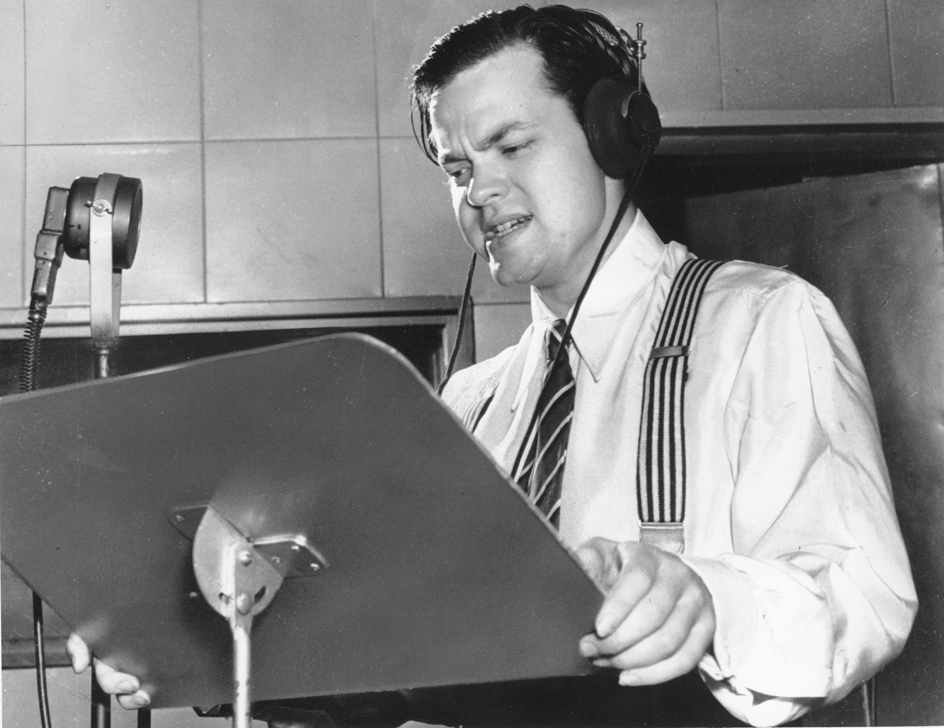
Some radio news reporters of the Golden Age became almost as well known as the top entertainers. They included Kathryn Cravens; Elmer Davis; Gabriel Heatter; H. V. Kaltenborn; Fulton Lewis, Jr.; Edward R. Murrow; Lowell Thomas; Dorothy Thompson; and Walter Winchell.
Newscasts became especially important during World War II (1939-1945). Millions of people turned to radio every day for latest news on the war. The governments of countries that fought in the war made widespread use of broadcasts to their own and other countries for propaganda purposes. The Voice of America, an agency of the United States government, began broadcasting overseas in 1942 to inform the world of America’s role in the war.
Franklin Delano Roosevelt, president of the United States from 1933 to 1945, used radio effectively. He held informal talks called “fireside chats.” The talks did much to help Roosevelt gain support for his policies. Earlier presidents, beginning with Woodrow Wilson in 1919, had spoken on radio. However, Roosevelt was the first to fully understand the great force of the medium and the opportunity it provided for taking government policies directly to the people. Other political leaders, including Winston Churchill of the United Kingdom and Charles de Gaulle of France, made use of radio to address their nations. 
Fireside chat on banking
Also popular and often influential were religious broadcasters. Listeners tuned in to hear sermons and commentary by such religious radio pioneers as the Protestant minister S. Parkes Cadman, the evangelist Aimee Semple McPherson, the rabbi Stephen S. Wise, and the controversial Roman Catholic priest Charles Coughlin.
The Golden Age was also the era of the “radio homemakers,” such as Ida Bailey Allen and Mary Margaret McBride. These women hosted daily programs directed at stay-at-home wives and mothers. The programs featured guest experts who gave advice on child-rearing, cooking, health, and other issues. These heavily sponsored shows appealed to women as an important consumer market for broadcasters and advertisers.
Radio since the 1950’s.
The rise of television in the 1950’s ended the Golden Age of radio broadcasting. People turned to TV for comedies, dramas, and variety shows, and these kinds of shows all but disappeared from radio. Many people believed television would cause radio broadcasting to become an unimportant communication medium with a small audience. Instead, radio’s audience has continued to grow, in spite of its competition from television.
After the Golden Age of Broadcasting, music became the major form of radio entertainment. Rock music, which was a new form of music in the 1950’s, became an important kind of music on radio. Broadcasts of rock music gained many listeners—especially teenagers—for radio. Talk shows and stations that broadcast only news also helped radio gain listeners. Thorough coverage of a topic or news event continues to be an important feature of such programs.
Portable radios also helped increase radio’s popularity. Such devices, including tiny personal radios with headphones, have made radio a source of individual, rather than family, enjoyment. In addition, automobile radios are now commonplace.
Still another aid to radio’s growth has been the development of stereophonic broadcasting. Stereo broadcasts began on a large scale in the 1960’s. In 1961, the FCC allowed only FM stations to broadcast in stereo in the United States to help them compete with AM stations. FM’s better sound quality enabled it to surpass AM in popularity by the late 1970’s. The FCC authorized AM stereophonic broadcasting in 1982.
In the late 1980’s and early 1990’s, researchers developed digital audio broadcasting (DAB), a system that converts sounds to digital (numeric) code before transmission. DAB was introduced at a world conference in Spain in 1992. In 1998, the first commercial DAB operation began in the United Kingdom. Because DAB can carry multiple signals, radio programs similar to those broadcast today may be supplemented by images, text, graphics, and other data. For example, information about local traffic problems could be transmitted over a DAB data channel. Drivers might receive this information as text, synthesized speech, or maps. An LCD (liquid crystal display) on the receiver might display the name and composer of any music played, the radio station’s telephone number, or an electronic program guide.
The 1990’s also saw an increase in the popularity of the “talk radio” format in the United States. Notable radio personalities who have found large, loyal listenerships with this format include the conservative political commentator Rush Limbaugh and the controversial entertainer Howard Stern. Beginning in 2006, Stern helped popularize subscription-based satellite radio when he made a highly publicized move from “terrestrial” (land-based) radio to Sirius Satellite Radio Inc. of New York City.
Satellite radio has now become an important new form of radio. Most satellite radio receivers are portable units mainly for use in automobiles, but equipment is also available for use with a home stereo, a portable radio, or a personal computer. Many models of cars now come equipped with satellite radio receivers. In 2008, Sirius merged with the country’s other satellite service, XM Satellite Radio Holdings Inc. of Washington, D.C., to create a single satellite radio network in the United States. The new company changed its corporate name to Sirius XM Radio Inc.
In 2006, a coalition of major radio station operators in the United States launched an effort to promote HD Radio—a technology that transmits programs digitally over existing AM and FM frequency bands. In its campaign, the alliance stressed the high-quality sound of HD Radio, as well as the fact that, unlike satellite radio, listeners could tune in to HD Radio for free. Thousands of AM and FM stations now broadcast with HD Radio technology. HD Radio has also become an option in many models of cars. However, a major challenge for HD Radio has been the higher cost of a digital radio compared with a regular AM-FM radio.
